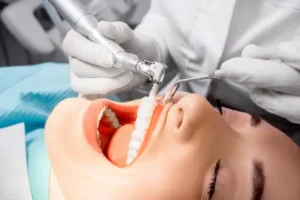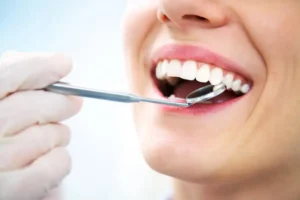Having a Tooth Extraction is one of the most common dental procedures performed, but that doesn’t make it any less daunting for patients. Extracting a tooth can seem like a scary prospect, whether due to overcrowding, severe decay, gum disease, or impaction.
At Stratland Dental in Glendale, AZ, we aim to make the process as smooth and comfortable as possible. This blog post will explore everything you need to know about Tooth Extractions, from the different types and procedures to aftercare and recovery tips. If you’re feeling anxious about tooth extractions, our Glendale dentist at Stratland Dental is here to ensure a stress-free and comfortable experience with expert care and guidance throughout the process.
What is tooth extraction?
The process of extracting a tooth from the mouth is called an extraction. This is a frequent dental procedure that may be required for a number of reasons, including overcrowding, gum disease, severe tooth decay, and impacted teeth (like wisdom teeth) that cannot erupt fully.
During a tooth extraction, the oral surgeon or dentist uses a local anesthetic to numb the surrounding tissue. Then, they extract the tooth from its jawbone socket using specialized dental tools. Usually, gauze is placed at the extraction site to help stop the bleeding and promote the formation of a blood clot.
Types of Tooth Extractions
There are two main categories of tooth extractions: simple and surgical.
Simple Extraction
When a tooth is evident in the mouth, a simple extraction is performed. The dentist uses dental forceps to extract the tooth after loosening it with an elevator tool. This type of extraction is relatively straightforward and can typically be done under local anesthesia.
Surgical Extraction
A surgical extraction, on the other hand, is required when a tooth has not fully erupted or is broken off at the gum line. This more complex procedure may involve making an incision in the gum tissue and potentially removing some bone around the tooth. An oral surgeon often performs surgical extractions, especially for impacted wisdom teeth. They usually require stronger anesthesia, such as IV sedation or general anesthesia.
Benefits of Tooth Extractions
While the goal of dentistry is to preserve natural teeth as much as possible, there are certain situations where extracting a tooth becomes the most viable option for protecting and improving a patient’s overall oral health. Despite the notion that losing a tooth is undesirable, tooth extractions can offer several significant benefits:
Relief from Pain and Infection: Severe tooth decay, cracks/fractures, or advanced gum disease can cause excruciating pain and infections that cannot be resolved through other treatments like fillings or root canals. Extracting the affected tooth eliminates the source of the pain and disease, allowing the mouth to heal properly.
Prevention of Further Damage: When a tooth is severely damaged or decayed, keeping it in the mouth risks the spread of infection to surrounding teeth and bone. Extracting the compromised tooth stops the decay or disease from progressing and safeguards the remaining healthy teeth and jawbone.
Improved Teeth Alignment: Overcrowded teeth can cause bite issues, increase the risk of gum disease and cavities, and make proper oral hygiene difficult. Extracting select teeth creates space for the remaining teeth to be orthodontically aligned into their correct positions for better function and aesthetics.
Resolution of Impacted Teeth: Wisdom teeth that do not have enough room to erupt fully become impacted, causing pain, swelling, bite issues, and increasing the risk of infection over time. Extracting impacted wisdom teeth prevents these problems from developing.
Preparation for Orthodontics: In some cases, extracting specific teeth is necessary to create the space required for successful orthodontic treatment to align the remaining teeth properly.
Although it’s not ideal to lose a natural tooth, in many situations, an extraction is the most responsible course of action for protecting and improving a patient’s long-term oral health when other treatments are not viable options. The benefits of resolving pain, preventing further damage, creating room for tooth alignment, and removing problematic teeth often outweigh the risks of keeping a severely compromised tooth.
Tooth Extraction Procedure
Depending on the type of extraction and your circumstances, the precise processes in a tooth extraction can change; however, they usually comprise the following:
- Administering anesthesia: A local anesthetic injection will numb the area around the tooth. Additional sedation may be used for surgical extractions.
- Loosening the tooth: Using an elevator tool, the dentist gently rocks the tooth back and forth to widen the socket.
- Extracting the tooth: Once sufficiently loosened, the tooth is firmly grasped with dental forceps and pulled out of the socket.
- Controlling bleeding: A gauze pack is placed over the socket to allow a blood clot to form and stop any bleeding.
- Closing the area: Stitches may be used to close the extraction site for surgical extractions.
Detailed post-operative instructions will be provided, but avoiding drinking from straws, smoking, or excessive spitting/rinsing for 24-48 hours after extraction is essential to prevent dislodging the blood clot.
Tooth Extraction Recovery
Although each patient’s healing process is different, you should anticipate some pain, swelling, and discomfort in the initial days following an extraction. Painkillers available over the counter can assist with any pain. After the surgery, swelling usually peaks 48 hours later and goes away in 5-7 days.
Sticking to a soft diet for the first few days is recommended to avoid irritating the extraction site. Gentle rinsing with salt water starting 24 hours after the procedure can promote healing. It’s also normal for a small amount of bleeding to occur for the first day or two.
Most people can return to their regular routine a day or two after a simple extraction. The recovery period may be more extended for surgical extractions, up to a week or more. Strenuous activity should be avoided during this time.
If swelling, pain, or bleeding persists or worsens after a few days, that could be a sign of a complication like a dry socket. Contact your dentist if you have any concerns during the recovery process.
Are you in need of a tooth extraction in Glendale, AZ?
Stratland Dental is a trusted Dentist in Glendale, AZ. Our team takes every measure to ensure your comfort and safety throughout the tooth extraction process. From transparency about what to expect to pain management techniques, we’re here to support you every step of the way. Don’t let dental anxiety keep you from getting the treatment you need!
While no one wants tooth extraction, sometimes it’s the best solution to prevent further oral health issues. You can confidently approach the process by understanding the different types of tooth extractions, what to expect during the procedure, and tips for a smooth recovery. Contact us if you need a tooth extraction in Glendale, AZ. Our experienced dental team will ensure you receive the highest quality care in a comfortable environment.







